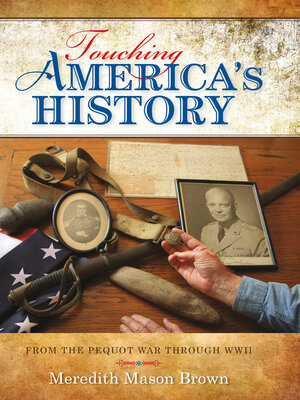Touching America's History
ebook ∣ From the Pequot War Through WWII · Encounters: Explorations in Folklore and Ethnomusicology
By Meredith Mason Brown

Sign up to save your library
With an OverDrive account, you can save your favorite libraries for at-a-glance information about availability. Find out more about OverDrive accounts.
Find this title in Libby, the library reading app by OverDrive.



Search for a digital library with this title
Title found at these libraries:
| Library Name | Distance |
|---|---|
| Loading... |
Objects that make the past feel real, from a stone axe head to a piece of John Brown’s scaffold—includes photos.
History isn’t just about abstract “isms”—it’s the story of real events that happened to real people. In Touching America’s History, Meredith Mason Brown uses a collection of such objects, drawing from his own family’s heirlooms, to summon up major developments in America’s history.
The objects range in date from a Pequot stone axe head, probably made before the Pequot War in 1637, to the western novel Dwight Eisenhower was reading while waiting for the weather to clear so the Normandy Invasion could begin, to a piece of a toilet bowl found in the bombed-out wreckage of Hitler’s home in 1945. Among the other historically evocative items are a Kentucky rifle carried by Col. John Floyd, killed by Indians in 1783; a letter from George Washington explaining why he will not be able to attend the Constitutional Convention; shavings from the scaffold on which John Brown was hanged; a pistol belonging to Gen. William Preston, in whose arms Gen. Albert Sidney Johnston bled to death after being shot at the Battle of Shiloh; and the records of a court-martial for the killing by an American officer of a Filipino captive during the Philippine War. Together, these objects call to mind nothing less than the birth, growth, and shaping of what is now America.
“Clearly written, buttressed by maps and portraits, Brown's book regales while showing the objectivity and nuance of a historian.”—Library Journal
“A whole new way of doing history…a novel form of story-telling.”—Joseph J. Ellis, Pulitzer Prize-winning author of Founding Brothers: The Revolutionary Generation
History isn’t just about abstract “isms”—it’s the story of real events that happened to real people. In Touching America’s History, Meredith Mason Brown uses a collection of such objects, drawing from his own family’s heirlooms, to summon up major developments in America’s history.
The objects range in date from a Pequot stone axe head, probably made before the Pequot War in 1637, to the western novel Dwight Eisenhower was reading while waiting for the weather to clear so the Normandy Invasion could begin, to a piece of a toilet bowl found in the bombed-out wreckage of Hitler’s home in 1945. Among the other historically evocative items are a Kentucky rifle carried by Col. John Floyd, killed by Indians in 1783; a letter from George Washington explaining why he will not be able to attend the Constitutional Convention; shavings from the scaffold on which John Brown was hanged; a pistol belonging to Gen. William Preston, in whose arms Gen. Albert Sidney Johnston bled to death after being shot at the Battle of Shiloh; and the records of a court-martial for the killing by an American officer of a Filipino captive during the Philippine War. Together, these objects call to mind nothing less than the birth, growth, and shaping of what is now America.
“Clearly written, buttressed by maps and portraits, Brown's book regales while showing the objectivity and nuance of a historian.”—Library Journal
“A whole new way of doing history…a novel form of story-telling.”—Joseph J. Ellis, Pulitzer Prize-winning author of Founding Brothers: The Revolutionary Generation







